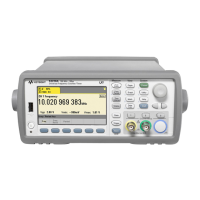53220A/53230A Measurements 3
Keysight 53220A/53230A User’s Guide 101
Notes
1 In the example, 200 time stamp readings are taken at a 1 MHz rate and stored
in the counter’s reading memory. The readings are then stored on a USB drive
connected to the counter’s front panel “host” port as comma-separated values
(CSV), in one measurement per line ASCII format.
2 The data returned with time stamp measurements include a scale factor
followed by the time stamp values (in seconds) themselves. The scale factor,
which is the number of input cycles per time stamp, increases as the frequency
of the input signal becomes greater than the time stamp rate specified. Time
stamp values will either be the signal period itself (scale factor = 1 for input
frequencies <
the time stamp rate), or the signal period multiplied by the scale
factor.
For example, a 10 MHz input signal and a 1 MHz time stamp rate might have a
scale factor of 11. The data for this measurement would be represented as:
1.10000000E+01 (scale factor: 11 cycles per time stamp)
1.10077637E-06 (1st time stamp = signal period x scale factor)
1.09963867E-06 (2nd time stamp = signal period x scale factor)
1.10005859E-06 .
1.09999023E-06 .
1.09988770E-06 .
1.10017578E-06 .
Dividing a time stamp value by the scale factor returns the input signal period
(e.g. 1.10077637E-06 / 11 = 1.00070579E-7).
3 See Chapter 4 for additional information on counter threshold levels and on
configuring the input signal path.
4 See Chapter 7 for information on data flow, reading memory, and on creating
data files.

